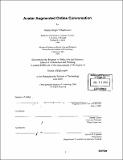| dc.contributor.advisor | Justine Cassell. | en_US |
| dc.contributor.author | Vilhjálmsson, Hannes Högni | en_US |
| dc.contributor.other | Massachusetts Institute of Technology. Dept. of Architecture. Program in Media Arts and Sciences. | en_US |
| dc.date.accessioned | 2006-03-24T16:11:30Z | |
| dc.date.available | 2006-03-24T16:11:30Z | |
| dc.date.copyright | 2003 | en_US |
| dc.date.issued | 2003 | en_US |
| dc.identifier.uri | http://hdl.handle.net/1721.1/29649 | |
| dc.description | Thesis (Ph. D.)--Massachusetts Institute of Technology, School of Architecture and Planning, Program in Media Arts and Sciences, 2003. | en_US |
| dc.description | Includes bibliographical references (p. 167-175). | en_US |
| dc.description.abstract | One of the most important roles played by technology is connecting people and mediating their communication with one another. Building technology that mediates conversation presents a number of challenging research and design questions. Apart from the fundamental issue of what exactly gets mediated, two of the more crucial questions are how the person being mediated interacts with the mediating layer and how the receiving person experiences the mediation. This thesis is concerned with both of these questions and proposes a theoretical framework of mediated conversation by means of automated avatars. This new approach relies on a model of face-to-face conversation, and derives an architecture for implementing these features through automation. First the thesis describes the process of face-to-face conversation and what nonverbal behaviors contribute to its success. It then presents a theoretical framework that explains how a text message can be automatically analyzed in terms of its communicative function based on discourse context, and how behaviors, shown to support those same functions in face-to-face conversation, can then be automatically performed by a graphical avatar in synchrony with the message delivery. An architecture, Spark, built on this framework demonstrates the approach in an actual system design that introduces the concept of a message transformation pipeline, abstracting function from behavior, and the concept of an avatar agent, responsible for coordinated delivery and continuous maintenance of the communication channel. A derived application, MapChat, is an online collaboration system where users represented by avatars in a shared virtual environment can chat and manipulate an interactive map while their avatars generate face-to-face behaviors. | en_US |
| dc.description.abstract | (cont.) A study evaluating the strength of the approach compares groups collaborating on a route-planning task using MapChat with and without the animated avatars. The results show that while task outcome was equally good for both groups, the group using these avatars felt that the task was significantly less difficult, and the feeling of efficiency and consensus were significantly stronger. An analysis of the conversation transcripts shows a significant improvement of the overall conversational process and significantly fewer messages spent on channel maintenance in the avatar groups. The avatars also significantly improved the users' perception of each others' effort. Finally, MapChat with avatars was found to be significantly more personal, enjoyable, and easier to use. The ramifications of these findings with respect to mediating conversation are discussed. | en_US |
| dc.description.statementofresponsibility | by Hannes Högni. Vilhjálmsson. | en_US |
| dc.format.extent | 205 p. | en_US |
| dc.format.extent | 11530553 bytes | |
| dc.format.extent | 11530361 bytes | |
| dc.format.mimetype | application/pdf | |
| dc.format.mimetype | application/pdf | |
| dc.language.iso | eng | en_US |
| dc.publisher | Massachusetts Institute of Technology | en_US |
| dc.rights | M.I.T. theses are protected by copyright. They may be viewed from this source for any purpose, but reproduction or distribution in any format is prohibited without written permission. See provided URL for inquiries about permission. | en_US |
| dc.rights.uri | http://dspace.mit.edu/handle/1721.1/7582 | |
| dc.subject | Architecture. Program in Media Arts and Sciences. | en_US |
| dc.title | Avatar augmented online conversation | en_US |
| dc.type | Thesis | en_US |
| dc.description.degree | Ph.D. | en_US |
| dc.contributor.department | Program in Media Arts and Sciences (Massachusetts Institute of Technology) | |
| dc.identifier.oclc | 53484032 | en_US |
